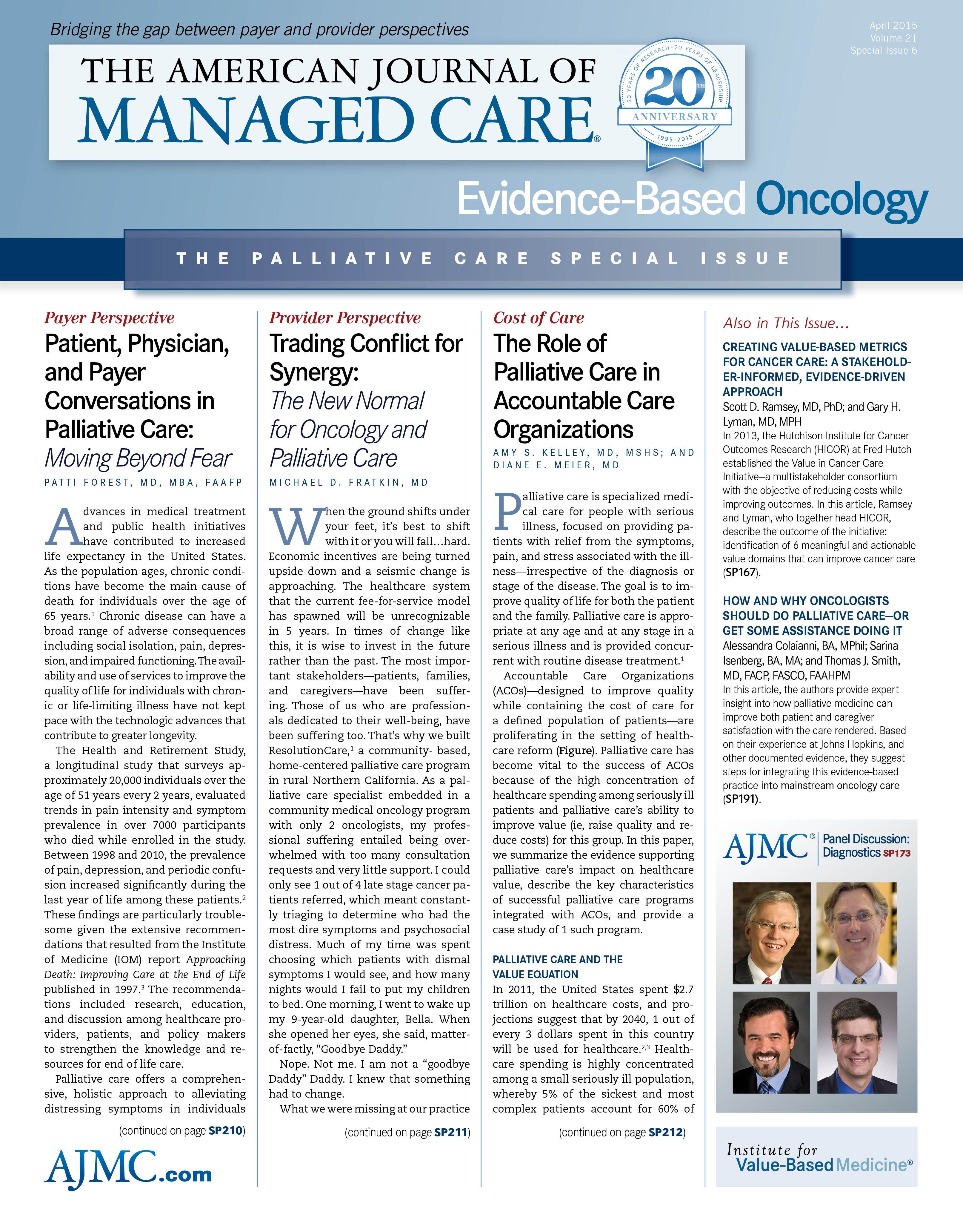Publication
Article
Evidence-Based Oncology
The Role of Palliative Care in Accountable Care Organizations
Author(s):
Palliative care is specialized medical care for people with serious illness, focused on providing patients with relief from the symptoms, pain, and stress associated with the illness—irrespective of the diagnosis or stage of the disease. The goal is to improve quality of life for both the patient and the family. Palliative care is appropriate at any age and at any stage in a serious illness and is provided concurrent with routine disease treatment.1
Figure
Accountable Care Organizations (ACOs)—designed to improve quality while containing the cost of care for a defi ned population of patients—are proliferating in the setting of healthcare reform (). Palliative care has become vital to the success of ACOs because of the high concentration of healthcare spending among seriously ill patients and palliative care’s ability to improve value (ie, raise quality and reduce costs) for this group. In this paper, we summarize the evidence supporting palliative care’s impact on healthcare value, describe the key characteristics of successful palliative care programs integrated with ACOs, and provide a case study of 1 such program.
PALLIATIVE CARE AND THE VALUE EQUATION
In 2011, the United States spent $2.7 trillion on healthcare costs, and projections suggest that by 2040, 1 out of every 3 dollars spent in this country will be used for healthcare.2,3 Healthcare spending is highly concentrated among a small seriously ill population, whereby 5% of the sickest and most complex patients account for 60% of healthcare costs.4 This population is characterized by both chronic conditions and functional limitations. Notably, most (89%) high-cost patients are not in the last year of life.5 Despite the intensity of spending, quality of care for this group is often low, marked by poor communication, high burden of pain and other symptoms, low satisfaction, and preference-discordant treatments.6-9
Data consistently demonstrate that palliative care improves quality of care for the seriously ill, and in so doing reduces need for emergency services and hospitalization. Compared with usual care, palliative care for seriously ill patients has been shown to reduce symptom distress,10-12 enhance quality of life,11-13 and decrease spiritual distress.14,15 Additionally, all studies that have compared patients receiving palliative care with those receiving usual care have shown equivalent survival rates and, in fact, palliative care interventions among select groups showed improved survival.11,16
Direct and indirect evidence suggests that palliative care also enhances family outcomes. Studies of palliative care and hospice have demonstrated improved family satisfaction and quality of life, decreased depression and anxiety, better bereavement adjustment, and improved survival among spouses.8,17-20 Indirect evidence supports possible mechanisms for these benefi ts. For example, families of patients receiving palliative care consultation reported greater attention to their emotional and spiritual needs and enhanced self-ef ficacy, compared with routine care.21 Those who could recall a discussion of goals of care—a key component of palliative care—experienced improved patient and caregiver quality of life, lower risk of major depression, and fewer feelings of regret.18,19 Furthermore, palliative care, and the discussion of goals of care in particular, is associated with lower rates of death in an intensive care unit and decreased use of other forms of high-intensity medical intervention,22 which have been linked to post-traumatic stress disorder and prolonged grief disorder among bereaved family members.18,19
Research has also demonstrated that the improved quality of care associated with palliative care leads to lower costs through prevention of symptom crises, by reducing depression, supporting family caregivers, and matching treatments with patient priorities (such as receiving care at home). To date, 15 studies have examined the effect of inpatient palliative care on hospital costs and all have found an association with reduced costs.23 A smaller group of studies has also demonstrated that outpatient palliative care can reduce costs and utilization across the entire course of illness.23,24 For example, a randomized controlled trial (RCT) of outpatient palliative care, in addition to standard oncologic care, among patients newly diagnosed with stage 4 non-small cell lung cancer found that those in the palliative care intervention group had better quality of life, improved survival (a gain of almost 3 months), lower rates of emergency department (ED) visits and hospital admissions within the last 30 days of life, were less likely to receive chemotherapy within the last 14 days of life, and were more likely to be referred to hospice 4 days or longer prior to death—measures indicative of higher quality and lower costs.11 Similarly, an RCT of a home-based palliative care program demonstrated improved satisfaction, fewer hospital and ED visits, and lower costs.25 Finally, an RCT of palliative care consultation in a primary care clinic setting resulted in fewer primary care and urgent care visits, yet no difference in use of the ED and hospital.26
While quality, the numerator of the value equation, is clearly of greatest priority, the importance of palliative care’s impact on costs cannot be ignored. In particular, ACO leadership—charged with providing high-quality care for a population of patients within strict budgetary constraints—have taken notice and many are embracing palliative care as a high-value solution for their highest risk patients. To date, over 70% of all ACO hospitals and 82% of ACO hospitals with 50 or more beds have active palliative care programs.27
CHARACTERISTICS OF SUCCESSFUL ACO PALLIATIVE CARE PROGRAMS
Successful ACO palliative care programs share several key characteristics. First, these programs attempt to identify and target the high-need and high-risk patient population, preferably before a crisis hospitalization. The specifi c methods and criteria for patient selection vary, but most include quantitative risk-prediction models, prior utilization of acute care services (eg, ED or hospital admission) and qualitative assessments from the medical record, interviews with patients or families, or referral by clinicians. Quantitative risk-prediction models, which typically include age, gender, medical diagnoses and procedures, prescription use, and/or prior utilization or health expenditure, may be easy to implement but may fail to identify key predictors of risk for future utilization, including patients with functional impairment, cognitive impairment, frailty, social determinants of poor health (such as lack of food and housing), and caregiver burden.28
Second, successful programs use trained staff and/or facilitators to elicit individualized patient goals that are then used to guide care plans. This goal-setting, comprehensive needs assessment (including medical, behavioral, and social issues), and care plan development process contributes toward building a personal relationship between the patient, the family, and the care team or care coordinator. The care plan integrates medical services, including expert pain and symptom management, with social and psychological/ behavioral health support to meet the individual patient and family needs. The goal is to help patients remain as independent as possible, staying home and avoiding the ED and the hospital.29
Another key characteristic of successful palliative care programs is attention to the patient’s family and social support. This involves an assessment of family capacity and willingness to provide care, evaluation of social and financial resources, as well as access to telephone support for patients and their caregivers, 24 hours a day, 7 days a week (www.capc.org/payertoolkit).
Finally, these programs offer flexible “dosing” of services, with the intensity of the intervention and services provided scaled to patients’ needs, which fluctuate over time and over the course of a complex, serious illness. This flexibility allows programs to maximize the ef ficiency of their own resource utilization.
A CASE STUDY OF ACO PALLIATIVE CARE INTEGRATION: SHARP, CALIFORNIA
Sharp HealthCare in San Diego, California, has developed the Transitions Advanced Illness Management program in conjunction with their af liated Pioneer ACO.30-32 Additional payer relationships with this program include Medicare Advantage and other private managed care contracts, but not Medicare fee-for-service. The cornerstone of the program, which aims to provide individualized, home-based palliative care for patients with serious illness—including those with progressive functional and nutritional decline—is a goals of care discussion with a skilled facilitator, followed by the development of a personalized care plan. Key features of the Transitions services include in-home patient and family education, medication reconciliation, counseling on what to expect and what to do if a crisis arises, caregiver assessment and support, completion of advance care planning and documentation (eg, Physician Orders for Life Sustaining Treatment forms), and expert symptom management.
Sharp notes that the average enrollment for patients on the Transitions program is 5 months, and 75% of enrollees have ultimately transitioned to hospice with an average hospice length of stay far exceeding the national average: 120 days, compared with 72 days. In addition, the program has signi cantly reduced acute care utilization, including a 57% reduction in ED visits, 54% reduction in hospital admissions, and 43% reduction in total costs of care.30
CONCLUSION
To strengthen value, ACOs are working to improve the quality of care and in so doing reduce reliance on avoidable emergency and acute care services for the highest risk, highest cost patient population. Palliative care, an essential partner in this work, has consistently demonstrated its ability to maximize healthcare value, specifi cally for seriously ill patients with the greatest need and highest risk. Successful programs that have integrated palliative care within an ACO share the following key practices:
• They rigorously target the high-risk population and proactively offer palliative care services.
• They engage in highly skilled discussions of patient goals and personalize care plans to match.
• They assess family and social resources and explicitly address these needs.
• They provide expert symptom management and coordinated medical care across settings.
• They offer maximum fl exibility with round-the-clock phone support and service intensity scaled to meet patients’ needs as they change over time.
EBO
REFERENCES
Providers seeking to develop a palliative care program within an ACO or other innovative payment model may fi nd additional resources and support at www.capc.org/payertoolkit.
1. About palliative care. Center to Advance Palliative Care website. https://www.capc.org/about/ palliative-care/. Accessed March 3, 2015.
2. The long-term outlook for health care spend- ing. Congressional Budget Office website. http://www.cbo.gov/ftpdocs/87xx/doc8758/ MainText3.1.shtml. Published November 13, 2007. Accessed July 25, 2014.
3. National health expenditure data. CMS website. http://www.cms.gov/Research-Statistics-Data-and-Systems/Statistics-Trends-and-Reports/NationalHealthExpendData/index.html. Updated May 5, 2014. Accessed July 25, 2014.
4. The Lewin Group. Individuals living in the community with chronic conditions and functional limitations: a closer look. HHS website. http:// aspe.hhs.gov/daltcp/reports/2010/closerlook. pdf. Published January 2010. Accessed March 9, 2015.
5. Aldridge MD, Kelley AS. Epidemiology of serious illness and high utilization of healthcare. In: Dying in America: Improving Quality and Honoring Individual Preferences Near the End of Life: Committee on Approaching Death: Addressing Key End of Life Issues. Washington, DC: National Academies Press; 2014.
6. Hanson LC, Danis M, Garrett J. What is wrong with end-of-life care? Opinions of bereaved family members. J Am Geriatr Soc. 1997;45(11):1339- 1344.
7. Institute of Medicine (US) Committee on Advancing Pain Research, Care, and Education. Relieving Pain in America: Blueprint for Transform- ing prevention, Care, Education, and Research. Washington, DC: National Academies Press; 2011.
8. Teno JM, Clarridge BR, Casey V, et al. Family perspectives on end-of-life care at the last place of care. JAMA. 2004;291(11):88-93.
9. Mitchell SL, Teno JM, Kiely DK, et al. The clini- cal course of advanced dementia. N Engl J Med. 2009;361(16):1529-1538.
10. Higginson IJ, Finlay I, Goodwin DM, et al. Do hospital-based palliative teams improve care for patients or families at the end of life? J Pain Symptom Manage. 2002;23(2):96-106.
11. Temel JS, Greer JA, Muzikansky A, et al. Early palliative care for patients with metastatic non-small-cell lung cancer. N Engl J Med. 2010;363(8):733-742.
12. Bakitas M, Lyons K, Hegel M, et al. Effects of a palliative care intervention on clinical outcomes in patients with advanced cancer: the Project ENABLE II randomized controlled trial. JAMA. 2009;302(7):741-749.
13. Jordhoy MS, Fayers P, Loge JH, Ahlner- Elmqvist M, Kaasa S. Quality of life in palliative cancer care: results from a cluster randomized trial. J Clin Oncol. 2001;19(18):3884-3894.
14. Steinhauser KE, Clipp EC, McNeilly M, Christakis NA, McIntyre LM, Tulsky JA. In search of a good death: observations of pa- tients, families, and providers. Ann Intern Med. 2000;132(10):825-832.
15. Balboni TA, Vanderwerker LC, Block SD, et al. Religiousness and spiritual support among advanced cancer patients and associations with end-of-life treatment preferences and quality of life. J Clin Oncol. 2007;25(5):555-560.
16. Higginson IJ, Bausewein C, Reilly CC, et al. An integrated palliative and respiratory care service for patients with advanced disease and refractory breathlessness: a randomised controlled trial. Lancet Respir Med. 2014;2(12):979-987.
17. Kane RL, Klein SJ, Bernstein L, Rothenberg R, Wales J. Hospice role in alleviating the emotional stress of terminal patients and their families. Med Care. 1985;23(3):189-197.
18. Wright AA, Zhang B, Ray A, et al. Associations between end-of-life discussions, patient mental health, medical care near death, and caregiver bereavement adjustment. JAMA. 2008;300(14):1665-1673.
19. Wright AA, Keating NL, Balboni TA, Matulonis UA, Block SD, Prigerson HG. Place of death: correlations with quality of life of patients with cancer and predictors of bereaved caregivers’ mental health. J Clin Oncol. 2010;28(29):4457-4464.
20. Abernethy AP, Currow DC, Fazekas BS, Luszcz MA, Wheeler JL, Kuchibhatla M. Specialized palliative care services are associated with improved short- and long-term caregiver outcomes. Supportive Care Cancer. 2008;16(6):585-597.
21. Gelfman LP, Meier DE, Morrison RS. Does palliative care improve quality? a survey of bereaved family members. J Pain Symptom Manage. 2008;36(1):22-28.
22. Morrison RS, Penrod JD, Cassel JB, et al. Cost savings associated with US hospital palliative care consultation programs. Archives Inter Med. 2008;168(16):1783-1790.
23. Smith S, Brick A, O’Hara S, Normand C. Evidence on the cost and cost-effectiveness of palliative care: a literature review. Palliat Med. 2014;28(2):130-150.
24. Rabow M, Kvale E, Barbour L, et al. Moving upstream: a review of the evidence of the impact of outpatient palliative care. J Palliat Med. 2013;16(12):1540-1549.
25. Brumley R, Enguidanos S, Jamison P, et al. Increased satisfaction with care and lower costs: results of a randomized trial of in-home palliative care. J Am Geriatr Soc. 2007;55(7):993-1000.
26. Rabow MW, Dibble SL, Pantilat SZ, McPhee SJ. The comprehensive care team: a controlled trial of outpatient palliative medicine consultation. Arch Intern Med. 2004;164(1):83-91.
27. National Palliative Care Registry Annual Survey Summary. Center to Advance Palliative Care website. https://registry.capc.org/cms/ portals/1/Reports/Registry_Summary%20Re- port_2014.pdf. Published July 2014. Accessed March 2, 2014.
28. Hong CS, Siegel AL, Ferris TG. Caring for high-need, high-cost patients: what makes for a successful care management program? Issue Brief (Commonw Fund). 2014;19:1-19.
29. Fried TR, Tinetti ME, Iannone L, O’Leary JR, Towle V, Van Ness PH. Health outcome prioritization as a tool for decision making among older persons with multiple chronic conditions. Arch Intern Med. 2011;171(20):1854-1856.
30. Hoefer DR, Johnson SK, Bender M. Development and preliminary evaluation of an innovation advanced chronic disease care model. J Clin Outcomes Manage. 2013;20(9):408-418.
31. Transitions Advanced Illness Management Program. Sharp website. http://www.sharp .com/hospice/transitions-advanced-illness-management-program.cfm. Accessed March 9, 2015.
32. Johnson SK, Kruse J. Transitions: a program that’s challenging the traditional healthcare mind- set. National Hospice and Palliative Care website. http://www.nhpco.org/sites/default/files/pub- lic/newsline/2010/Sept_10_NL.pdf. Published September 2010. Accessed March 12, 2015.

Newsletter
Stay ahead of policy, cost, and value—subscribe to AJMC for expert insights at the intersection of clinical care and health economics.






